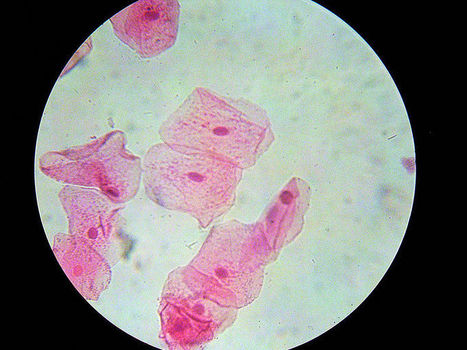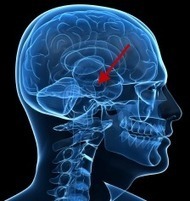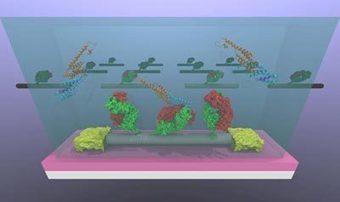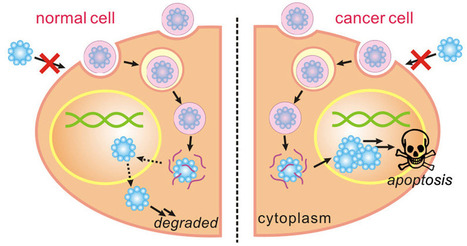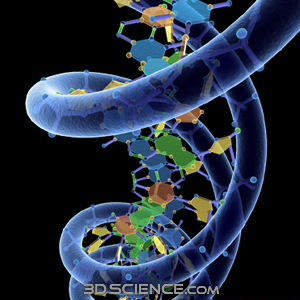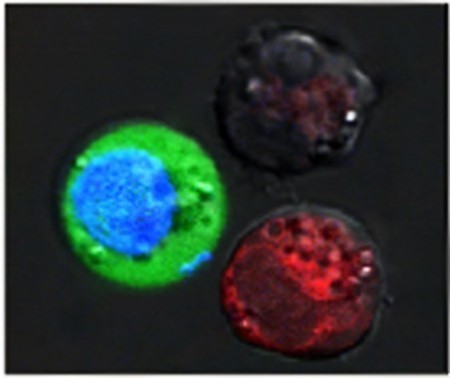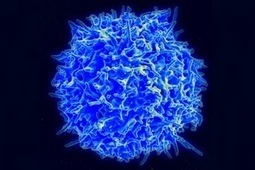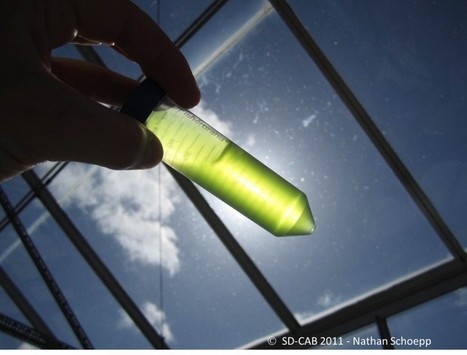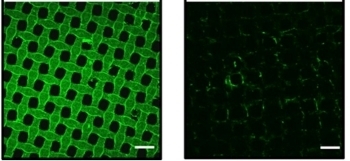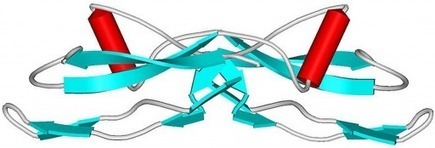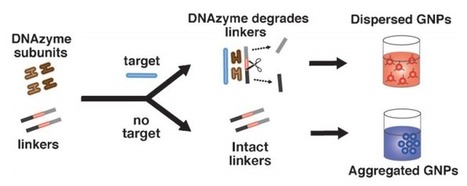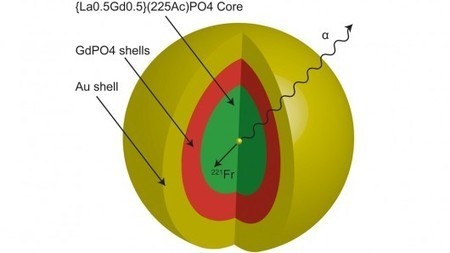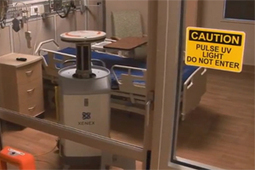 Your new post is loading...
 Your new post is loading...
Led by researchers at Harvard School of Public Health (HSPH) and the Institute for Bioengineering of Catalonia (IBEC), investigators found that epithelial cells — the type that form a barrier between the inside and the outside of the body, such as skin cells — move in a group, propelled by forces both from within and from nearby cells — to fill any unfilled spaces they encounter. The discovery about how cells move inside the body may provide scientists with crucial information about disease mechanisms such as the spread of cancer or the constriction of airways caused by asthma.
After being diagnosed with prostate cancer, men who eat a diet high in vegetable fats, such as those in nuts and olive oil, may be less likely to have their disease spread, a new study suggests.
Scientists discover how to slow down aging in mice and increase longevity
Blocking a specific protein complex in the hypothalamus and injecting a hormone slow aging and cognitive decline
Their discovery of a specific age-related signaling pathway opens up new strategies for combating diseases of old age and extending lifespan.
New technique could give conventional immunoassays a run for their money Carbon-nanotube transistors could be used to detect minute quantities of disease biomarkers, such as the proteins implicated in prostate cancer, according to new experiments by researchers in the US. The technique could rival conventional methods when it comes to sensitivity, cost and speed. Conventional techniques to detect proteins are typically based on some form of "immunoassay", with the most famous of these being enzyme-linked immunosorbent assay (ELISA). This technique involves introducing an enzyme-modified antibody protein to an unknown amount of target molecule or protein, known as an antigen, and allowing them to bind together. Unreacted antibodies are washed away, leaving behind only antibody–antigen pairs. The reaction can usually be detected by a colour change in the solution or by a fluorescent signal. The degree of colour change or fluorescence depends upon the number of enzyme-modified antibodies present, which in turn depends on the initial concentration of antigen in the sample. Although such tests are routinely used in hospitals and clinics, they are quite long, taking several days or even weeks to complete. They are also costly, complicated to perform and can only detect single proteins at a time. "Our new nanotube sensors are relatively simple compared to these ELISA tests," team member Mitchell Lerner, at the University of Pennsylvania, told physicsworld.com. "Detection occurs in just minutes, not days, and even at the laboratory scale, the cost of an array of 2000 such sensors is roughly $50 or 2.5 cents per sensor." More importantly still, the sensors are much more sensitive to the target proteins in question. Indeed the Pennsylvania researchers showed that they could detect a prostate-cancer biomarker called osteopontin (OPN) at 1 pg/mL, which is roughly 1000 times lower than that possible with clinical ELISA measurements.
Detecting Lyme disease: The team, which is led by A T Charlie Johnson of Penn's Department of Physics and Astronomy, made its nanotube sensors by attaching OPN-binding antibodies to carbon-nanotube transistors on a silicon chip. Many proteins in the body bind very strongly to specific target molecules or proteins, and OPN is no exception. When the chip is immersed in a test sample, the OPN binds to the antibodies, something that changes the electronic characteristics of the transistor. Measuring the voltage and current through each device thus allows the researchers to accurately measure how much OPN there is in the sample.
Via Dr. Stefan Gruenwald
A degradable nanoscale shell to carry proteins to cancer cells and stunt the growth of tumors without damaging healthy cells has been developed by a team led by researchers from the UCLA Henry Samueli School of Engineering and Applied Science.
Tiny shells (about 100 nanometers in length, roughly half the size of the smallest bacterium) are composed of a water-soluble polymer that safely delivers a protein complex to the nucleus of cancer cells to induce their death. The shells degrade harmlessly in non-cancerous cells.
The process does not present the risk of genetic mutation posed by gene therapies for cancer, or the risk to healthy cells caused by chemotherapy, which does not effectively discriminate between healthy and cancerous cells, said Yi Tang, a professor of chemical and biomolecular engineering and a member of the California NanoSystems Institute at UCLA.
A recent study has found that more fatal heart attacks and strokes occur during the winter than at other times of the year. And it doesn’t seem to matter if the winter is occurring in the warmer climes of Southern California or the frostier ones of Boston.
What if you could improve your memory, become smarter and stronger, and live in an ageless disease-free body – just by taking a pill? Though this may sound like the stuff of science fiction, experts are developing a better understanding of our genetic mysteries, including the powerful influence that DNA wields on our lives. It's becoming clear that cancer, heart disease, diabetes, obesity; most mental disorders, and many other ailments, could all be the result of a clash between genes we inherited from our past, and today's modern environment.
U.S. scientists are developing a technique that will target and kill cancer cells while simultaneously treating others in the same sample. Centered on fine-tuning the use of cancer destroying nanobubbles, the research holds promise for treating cancer patients in a way that’s far more targeted than chemotherapy.
Researchers at the RIKEN Research Center for Allergy and Immunology in Yokohama, Japan have devised a way to increase the number of cancer-fighting T cells and make up for their short life spans with the hope that the superior numbers of immune cells will enable them to overwhelm and conquer.
“Exercise can partially reverse the effects of the aging process ... a minimum quantity and quality of exercise decreases the risk of death, prevents development of certain cancers, lowers the risk of osteoporosis, and increases longevity.” (Gremeaux V et al. 2012) Now, a data analysis from Canada pinpoints the lifespan extension different groups can expect from regular, moderate exercise.
New research suggests it might reduce the risk of developing cancer, dementia and other diseases.
Among people who have a genetic susceptibility to colon cancer, those whose diets are heavy in junk food have an even higher risk, according to a new study.
"These patients have this very high risk because of this (genetic) mutation they have, but it might be that they could reduce the number of (tumors) by having a more healthy lifestyle," said Akke Botma, the lead author of the study.
Biologists at UC San Diego have succeeded in genetically engineering algae to produce a complex and expensive human therapeutic drug used to treat cancer.
Their achievement opens the door for making these and other “designer” proteins in larger quantities and much more cheaply than can now be made from mammalian cells.
|
An international team of scientists has recently reported success in the first phase of clinical trials in which MS victims’ immune systems were conditioned to become much more tolerant of myelin.\ In the study, white blood cells were obtained from nine MS-afflicted test subjects. These cells were specially processed, coupled with myelin antigens, and then injected intravenously back into their respective donors – up to 3 billion of these dead, treated cells were injected into each person. When they entered the spleen, which filters dead cells from the bloodstream, both the white blood cells themselves and their myelin antigen payloads were identified by the body as being innocuous. This caused the immune system to become 50 to 75 percent less reactive to myelin, depending on the person and the number of cells injected.
Medical researchers think specially tailored RNA sequences could turn off genes in patients’ cells to encourage wound healing or to kill tumor cells. Now researchers have developed a nanocoating for bandages that could deliver these fragile gene-silencing RNAs right where they’re needed (ACS Nano 2013, DOI:10.1021/nn401011n). The team hopes to produce a bandage that shuts down genes standing in the way of healing in chronic wounds. Small interfering RNAs, or siRNAs, derail expression of specific genes in cells by binding to other RNA molecules that contain the code for those genes. Biologists have developed siRNAs that target disease-related genes. But for these siRNAs to reach the clinic, researchers must find a way to deliver the molecules safely to the right cells. Unfortunately, free oligonucleotides like siRNAs don’t fare well inside the body or cells as enzymes and acids quickly chop them up, says Paula T. Hammond, a chemical engineer at Massachusetts Institute of Technology. Other groups have tackled this delivery challenge by attaching siRNAs to chemical carriers that protect the oligonucleotides as they travel through the bloodstream. The pharmaceutical company Sanofi-Aventis asked Hammond to design a vehicle that would work at the site of a wound or tumor, releasing the siRNAs over a long period of time. The company hoped that putting the biomolecules right where they’re needed, without them having to survive a trip through the bloodstream, would increase the efficacy of the treatment. Hammond and her colleagues produced an siRNA-containing nanocoating that could be applied to a wide range of medical materials, such as bandages or biodegradable polymers doctors could implant during surgery to prevent an excised tumor from coming back. As the coating slowly dissolves, it releases siRNA molecules tethered to protective nanoparticles. The thin films consist of two different materials: a peptide called protamine sulfate and calcium phosphate nanoparticles decorated with the therapeutic siRNAs. Other researchers have shown that similar nanoparticles help the nucleotides evade destruction once they’re taken up by cells (J. Controlled Release 2010, DOI: 10.1016/j.jconrel.2009.11.008). The team alternately dips whatever they want to coat in water solutions of the two materials. The RNA and nanoparticles are negatively charged, and the peptides are positively charged. The two substances cling together due to electrostatic force, producing a film when the water dries. To test their delivery method, the researchers coated woven nylon bandages with 80-nm-thick films and applied the bandages to layers of human and animal cells in culture. In one experiment, a bandage loaded with 19 µg of siRNA per square centimeter released two-thirds of its load over 10 days. Other bandages made using siRNAs targeting the gene for fluorescent green protein almost completely shut down the protein’s production in cells expressing the gene. Hammond says the group is now testing bandages that knock down MMP9, a collagen-destroying protein associated with slow healing in chronic wounds.
Via Dr. Stefan Gruenwald
Researchers at Northeastern University in Boston have developed a gene therapy approach that may one day stop Parkinson’s disease (PD) in it tracks, preventing disease progression and reversing its symptoms.
The novelty of the approach lies in the nasal route of administration and nanoparticles containing a gene capable of rescuing dying neurons in the brain.
A diagnostic system using DNA powder and gold nanoparticles being developed by scientists at the University of Toronto’s Institute of Biomaterials and Biomedical Engineering could provide rapid point-of-care diagnosis of the world’s leading infectious diseases in the near future. BBME PhD student Kyryl Zagorovsky has developed a rapid diagnostic biosensor that will allow technicians to test for multiple diseases at the same time with one small sample, and with high accuracy and sensitivity. The biosensor relies upon gold nanoparticles, which change color.
Gold nanoparticles have already shown promise in precisely highlighting brain tumors, “blowing up” individual diseased cells, and developing a lung cancer breath test. Now researchers have created gold nanoparticles that allow an alpha particle-emitting element to be directed to small cancer tumors. The researchers say the gold coating keeps the powerful radioactive particles in place at the cancer site so they do negligible damage to healthy organs and tissue.
Biologists at Tufts University School of Arts and Sciences have discovered a bioelectric signal that can identify cells that are likely to develop into tumors. The researchers also found that they could lower the incidence of cancerous cells by manipulating the electrical charge across cells' membranes.
Scientists believe the genes of virus-resistant and long-living wild bats might hold clues to treating cancer and infectious diseases in humans. The theory is that when bats started flying millions of years ago, something changed in their DNA that provides resistance to viruses and helps give them a relatively long life. The researchers hope a better understanding of bat evolution could lead to new treatments for disease and aging in humans.
University of North Carolina Lineberger Comprehensive Cancer Center researchers have developed a strain of mice that turns on a gene from fireflies to provide a visual indication of aging and tumor growth in mice. The mice light up whenever another mouse gene, p16INK4a (p16) is is activated (in cells undergoing senescence, the p16 gene is switched on).
It’s a staggering modern-day irony that the most common complication for hospital patients is acquiring an infection during their visit, affecting 1 in 20 patients in the US. It’s a problem estimated to cause millions of infections with 100,000 or so leading to death per year and a whopping $45 billion annually in hospital costs. If this isn’t bad enough, the tragedies from deadly superbugs within healthcare facilities are on the rise and will likely continue as the last lines of antibiotics fail without any new drugs moving fast enough up the pipeline to help. Fortunately, an alternative to medication promises to vastly improve the disinfection of hospital rooms, thanks to a UV light-emitting robot from Xenex Healthcare.
Chronic diseases linked to obesity and overconsumption of food are now a bigger global healthcare burden than illness and disease caused by malnutrition, according to the most comprehensive disease report ever produced on global health issues.
Scientists have identified a protein that appears to hold the key to creating more effective drug treatments for melanoma, one of the deadliest cancers.
LONDON (Reuters) - The world has made huge progress fighting killer infectious diseases, but as a result we now lead longer and sicker lives, with health problems that cause us years of pain, disability...
|



 Your new post is loading...
Your new post is loading...

